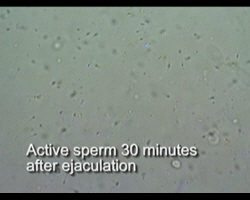This is the Archived Desktop Edition.
You should be transferred to the Newest Edition for Desktop and Mobile within 2 seconds.
|
Lesson 2: Embryology and Fetal Development
Pregnancy is a sequence of events that normally includes fertilization, implantation, embryonic growth, and fetal growth that terminates in birth (see figure 2-1). Even though there are many events that take place in the reproductive cycle, we cannot include every detail in this lesson. However, the following information will give descriptive events of what goes on in the uterus prior to birth. This information will also help you to recognize potential problems and to be able to intervene in the nursing care process.
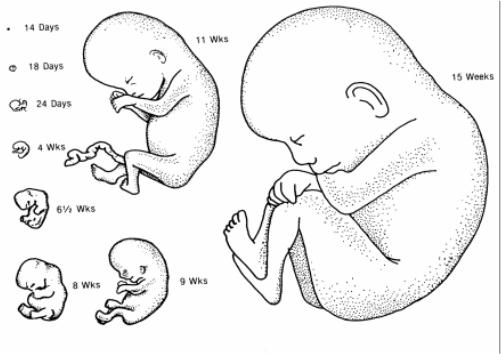
Figure 2-1. Growth of the fetus.
2-2. PRINCIPLES OF FERTILIZATION (CONCEPTION)
a. Fertilization refers to the joining together of the ovum (egg) and sperm cells. The ovum originates in the graafian follicle within the ovary. The sperm cell originates in the testes. The microscopic union of sperm and ovum increase in size more than 20 billion times from conception to birth. See figure 2-2 for union of sperm and ovum.
b. During sexual intercourse, 2 to 5 ml of semen, usually containing more than 300 million sperm, is ejaculated into the female's vagina. By flagellar (wiggly) movement, the sperm make their way through the fluids of the cervical mucous, across the endometrium, and into the fallopian tube to meet the descending ovum in the ampulla of the fallopian tube (see figure 2-3). Only one sperm is required for actual fertilization, but the presence of many increases the chances for one to penetrate. The union between ovum and sperm occurs in the outer third of the fallopian tube.
c. The combined ovum and sperm, referred to as the zygote, begins rapid cell division and in 2 to 3 days becomes a structure referred to as morula. The morula is a rapidly growing structure and reaches the uterus in approximately 4 days.
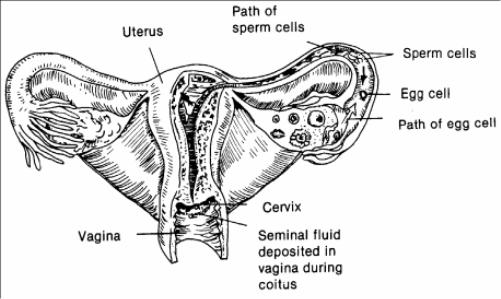
Figure 2-3. Travel of sperm to ovum.
a. The morula floats in the uterus for 3 to 4 days, gaining in size and weight. At this time, the hollow fluid-filled morula, now called blastocyst burrows into the uterine lining.
b. The outer surface of the blastocyst becomes covered with finger-like projections called chorionic villi. Chorionic villi aid in the process of implantation into the endometrium (decidua). Villi also manufacture human chorionic gonadotropin (HCG) which signal the corpus luteum within the ovaries to continue production of progesterone and estrogen to prevent menstruation.
c. Implantation normally occurs in the upper, posterior wall of the uterus. The point of implantation becomes the origin for the placenta and umbilical cord.
NOTE
: See figure 2-4 for associated events of fertilization and implantation.
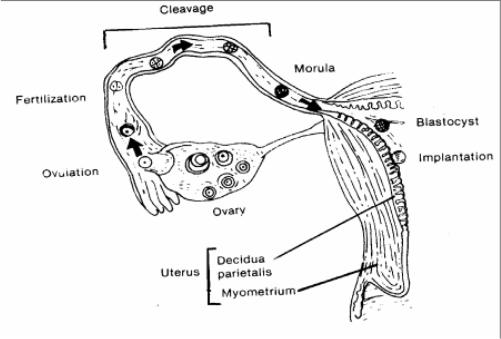
Figure 2-4. Events of fertilization and implantation.
|
Chromosomes are small, threadlike structures within each cell that contain genes, which carry genetic instructions. These genes control the physical and chemical traits inherited by children from their parents. The inherited traits are color of the eyes, sex, height, and skin color.
a. The female has 23 pairs of chromosomes. The pair of chromosomes that determined her sex are named "XX." The ovum carries one chromosome from each of the female's pairs (23 chromosomes). The ovum can only carry an "X" sex chromosome.
b. The male has 23 pairs of chromosomes. The pair of chromosomes that determined his sex are named "XY." The sperm carries one chromosome from each of the male's pairs (23 chromosomes). The sperm can carry either an "X" or a "Y" sex chromosome.
c. If the ovum is fertilized by a sperm carrying an "X" chromosome, the child is a girl.
d. If the ovum is fertilized by a sperm carrying a "Y" chromosome, the child is a boy.
e. The sperm of the father always determines the child's sex (see figure 2-5).
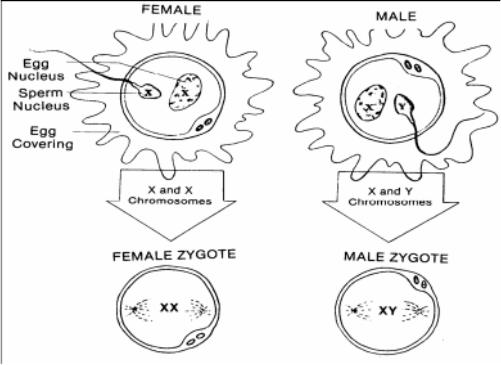
Figure
2-5. Genetic determination of sex.
The Brookside Associates Medical Education Division is dedicated to the development and dissemination of medical information that may be useful to medical professionals and those in training to become medical professionals. This website is privately-held and not connected to any governmental agency. The views expressed here are those of the authors, and unless otherwise noted, do not necessarily reflect the views of the Brookside Associates, Ltd., any governmental or private organizations. All writings, discussions, and publications on this website are unclassified.
© 2007 Medical Education Division, Brookside Associates, Ltd. All rights reserved
